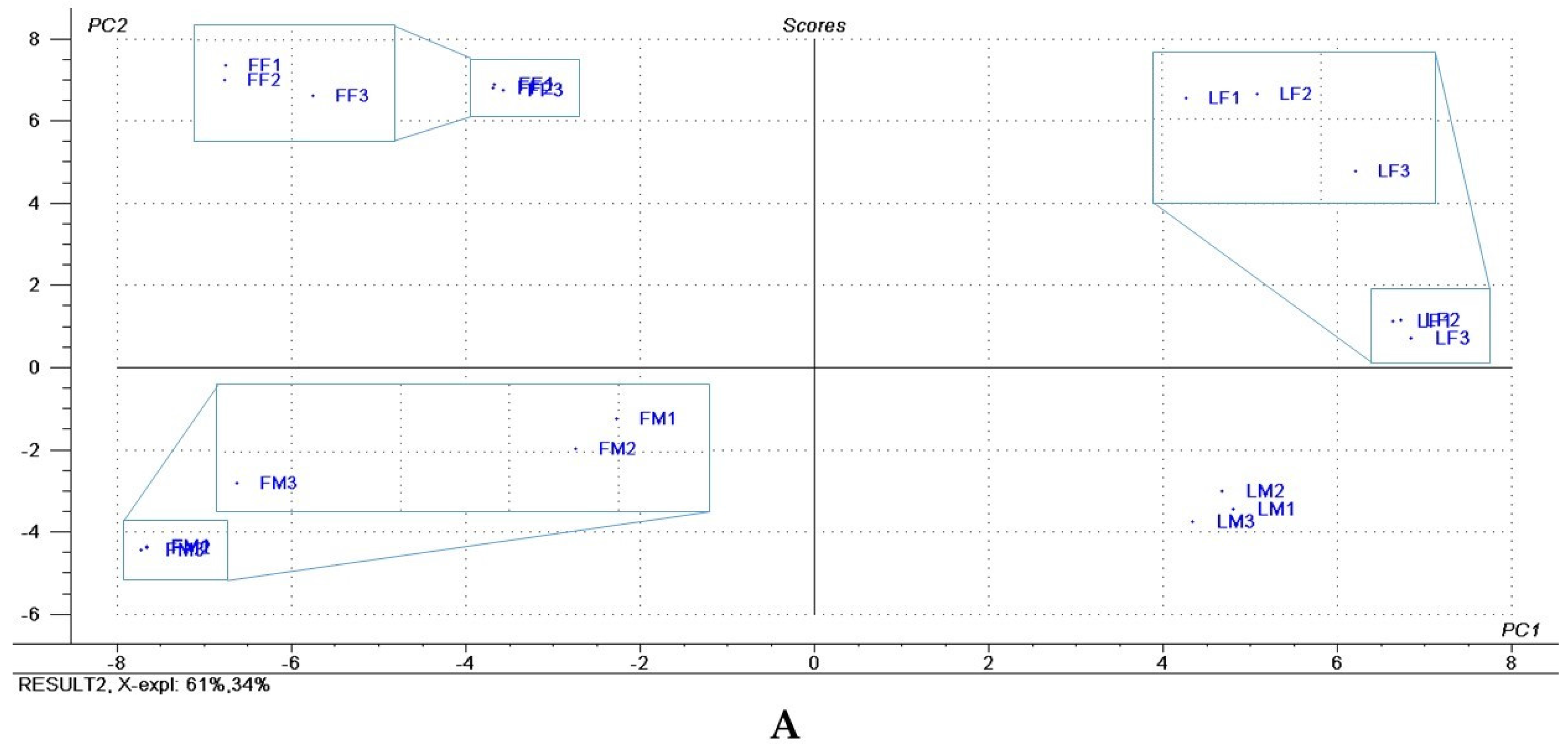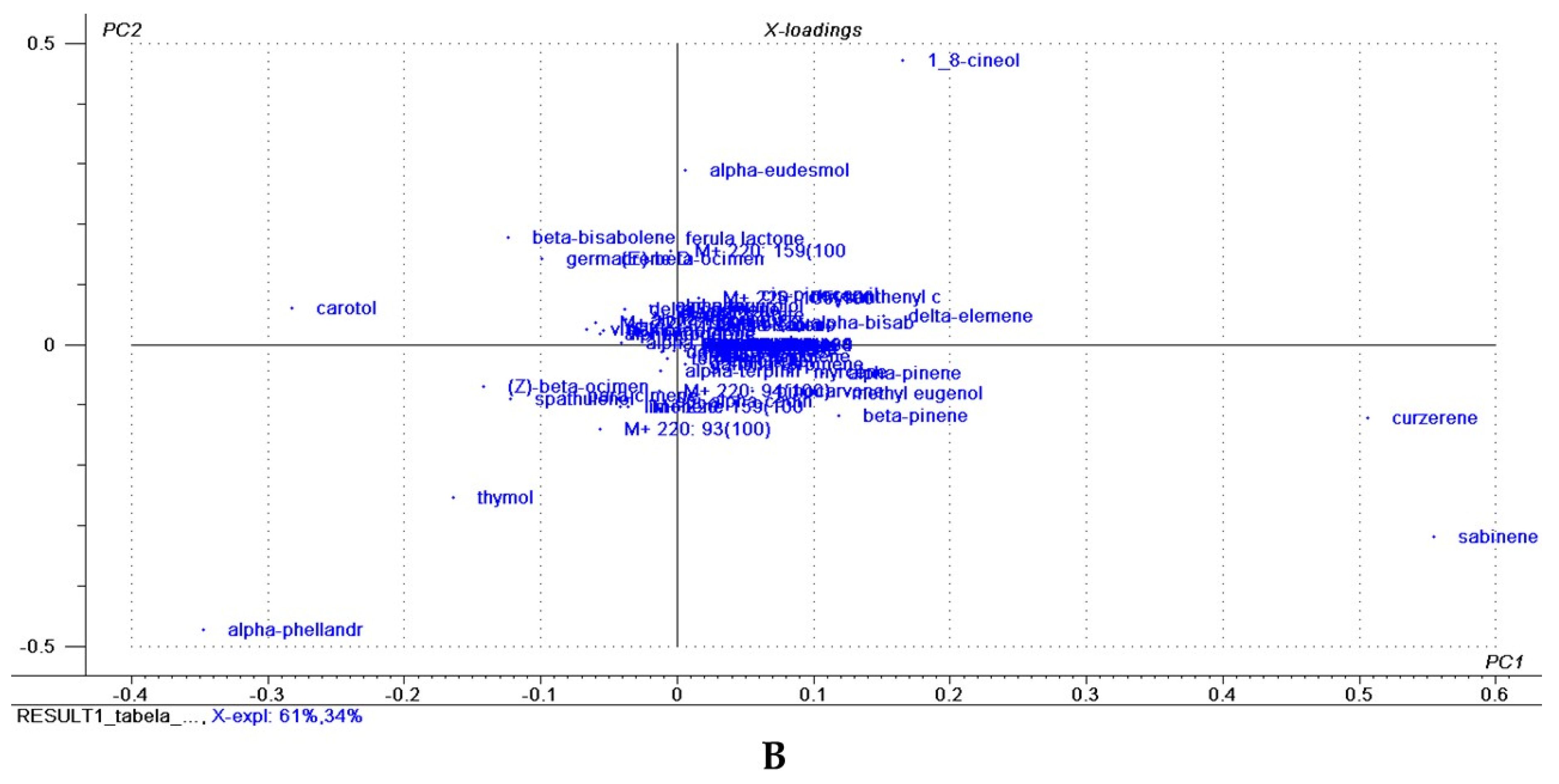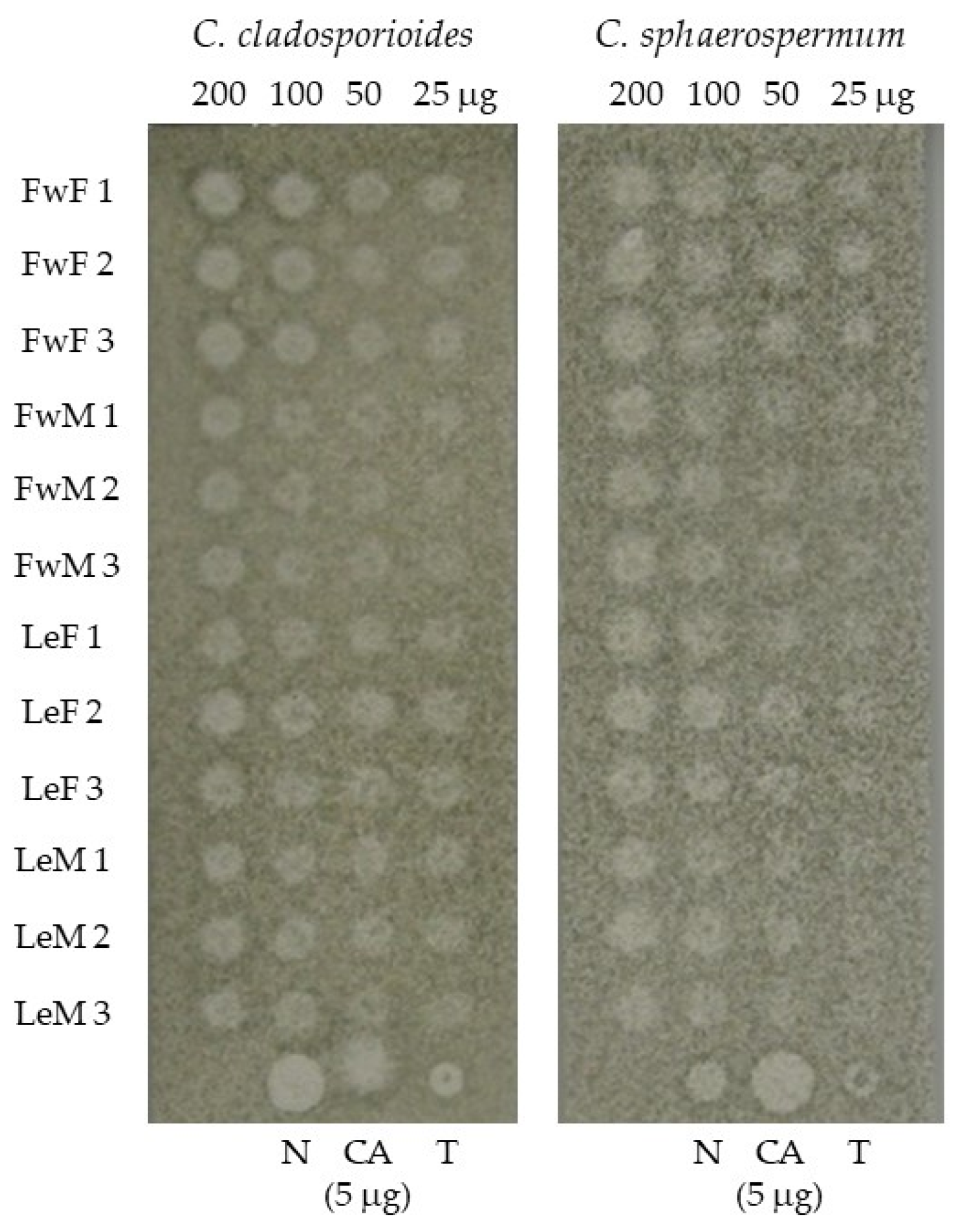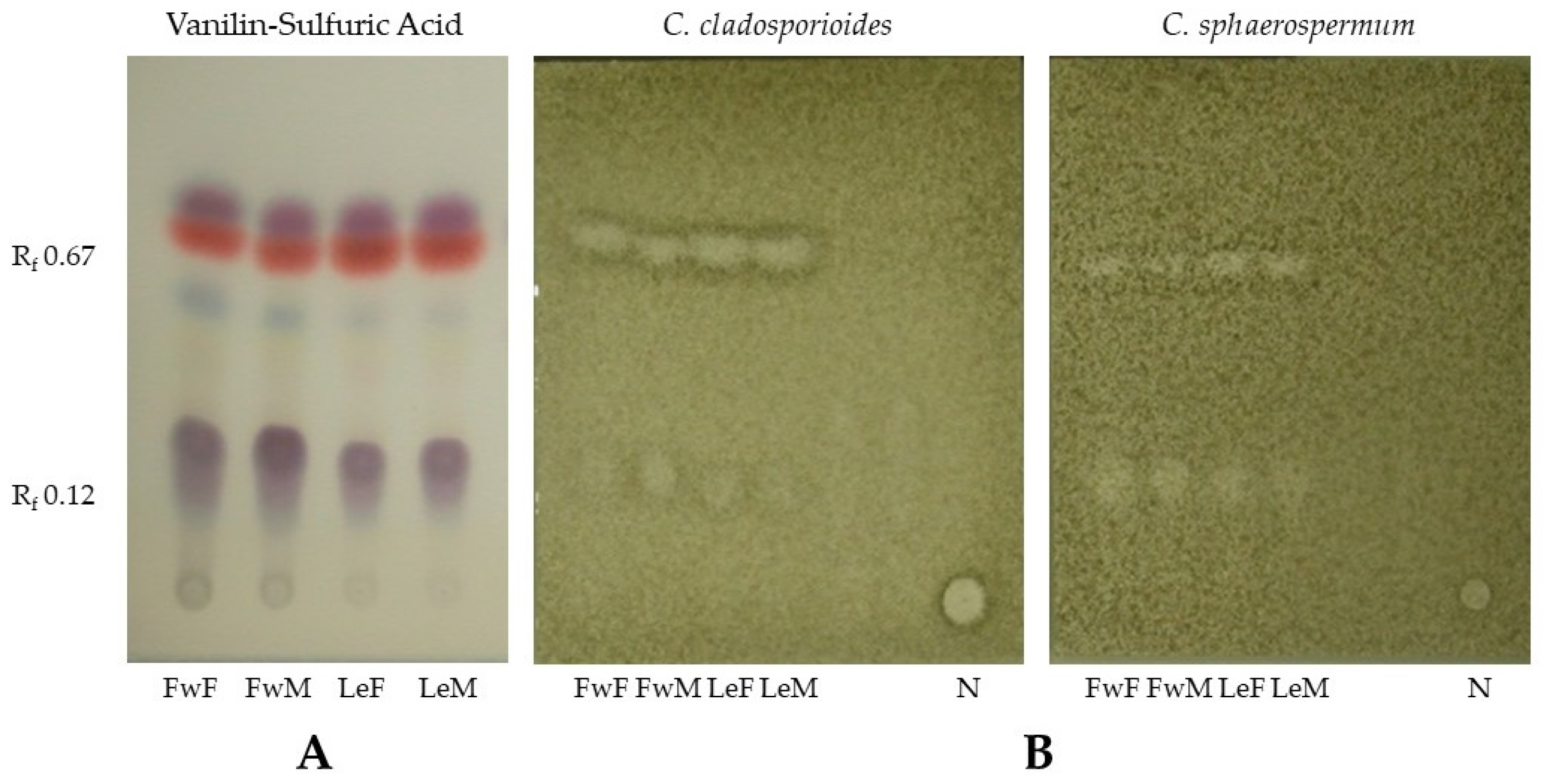Chemical Composition, Antifungal and Antioxidant Activities of Hedyosmum brasiliense Mart. ex Miq. (Chloranthaceae) Essential Oils
Abstract
:1. Introduction
2. Materials and Methods
2.1. Plant Material
2.2. Extraction of the Essential Oils
2.3. GC-MS Analysis
2.4. Principal Component Analysis of the Essential Oils
2.5. Antifungal Activity
2.6. In Vitro Antioxidant Activities
3. Results
3.1. Chemical Composition of the Essential Oil
3.2. Antifungal Activity
3.3. Antioxidant Activity
4. Discussion
5. Conclusions
Supplementary Materials
Acknowledgments
Author Contributions
Conflicts of Interest
References
- Todzia, C.A. Chloranthaceae: Hedyosmum. Fl. Neotrop. Monogr. 1988, 48, 1–140. [Google Scholar]
- Reitz, R. Clorantáceas. In Flora Ilustrada Catarinense; Reitz, R., Ed.; parte I, fasc. Clor.; Herbário ‘Barbosa Rodrigues’: Itajaí, Brazil, 1965; pp. 1–10. [Google Scholar]
- Guerrini, A.; Sacchetti, G.; Grandini, A.; Spagnoletti, A.; Asanza, M.; Scalvenzi, L. Cytotoxic Effect and TLC Bioautography-Guided Approach to Detect Health Properties of Amazonian Hedyosmum sprucei Essential Oil. Evid. Based Complement. Altern. Med. 2016, 2016, 1638342. [Google Scholar] [CrossRef] [PubMed]
- Sylvestre, M.; Pichette, A.; Longtin, A.; Martin, M.A.C.D.K.; Bercion, S.R.; Legault, J. Chemical Composition of Leaf Essential Oil of Hedyosmum arborescens and Evaluation of Its Anticancer Activity. Nat. Prod. Commun. 2007, 2, 1269–1272. [Google Scholar]
- De Feo, V.; Soria, R.U. Composition of the Essential Oil of Hedyosmum scabrum (R. et P.) Solms (Chloranthaceae). J. Essent. Oil Bearing Plants 2007, 10, 41–45. [Google Scholar] [CrossRef]
- Delgado, P.A.; Quijano, C.E.; Morales, G.; Pino, J.A. Composition of the Essential Oil From Leaves and Fruits of Hedyosmum colombianum Cuatrec. Grown in Colombia. J. Essent. Oil Res. 2010, 22, 234–236. [Google Scholar] [CrossRef]
- Lorenzo, D.; Loayza, I.; Dellacassa, E. Composition of the essential oils from leaves of two Hedyosmum spp. from Bolivia. Flavour Fragr. J. 2003, 18, 32–35. [Google Scholar] [CrossRef]
- Mundina, M.; Vila, R.; Tomi, F.; Cicció, J.F.; Ibañez, C.; Adzet, T.; Casanova, J.; Cañigueral, S. Composition of the essential oils from leaves and fruits of three Hedyosmum species from Costa Rica. Flavour Fragr. J. 1999, 4, 190–194. [Google Scholar] [CrossRef]
- Rossi, L. Chloranthaceae. In Flora Fanerogâmica do Estado de São Paulo; Wanderley, M.G.L., Shepherd, G.J., Giulietti, A.M., Melhem, T.S., Bittrich, V., Kameyama, C., Eds.; Instituto de Botânica: São Paulo, Brazil, 2002; Volume 2, pp. 83–84. [Google Scholar]
- Occhioni, P. Contribuição ao estudo da família Chloranthaceae com especial referência ao gênero Hedyosmum Sw. In Tese de Doutorado; Faculdade Nacional de Farmácia: Rio de Janeiro, Brazil, 1954. [Google Scholar]
- Trentin, A.P.; Santos, A.R.; Guedes, A.; Pizzolatti, M.G.; Yunes, R.A.; Calixto, J.B. Antinociception caused by extract of Hedyosmum brasiliense and its active principle, the sesquiterpene lactone 13-hydroxy-8,9-dehydroshizukanolide. Planta Med. 1999, 65, 517–521. [Google Scholar] [CrossRef] [PubMed]
- Tolardo, R.; Zetterman, L.; Bitencourtt, D.R.; Mora, T.C.; Oliveira, F.L.; Biavatti, M.W.; Amoah, S.K.S.; Bürger, C.; Souza, M.M. Evaluation of behavioral and pharmacological effects of Hedyosmum brasiliense and isolated sesquiterpene lactones in rodents. J. Ethnopharmacol. 2010, 128, 63–70. [Google Scholar] [CrossRef] [PubMed]
- Gonçalves, A.E.; Burger, C.; Amoah, S.K.S.; Tolardo, R.; Biavatti, M.W.; Souza, M.M. The antidepressant-like effect of Hedyosmum brasiliense and its sesquiterpene lactone, podoandin in mice: Evidence for the involvement of adrenergic, dopaminergic and serotonergic systems. Eur. J. Pharmacol. 2012, 674, 307–314. [Google Scholar] [CrossRef] [PubMed]
- Leitolis, A.; Amoah, S.K.S.; Biavatti, M.W.; Silva-Santos, J.E. Sesquiterpene lactones from Hedyosmum brasiliense induce in vitro relaxation of rat aorta and corpus cavernosum. Braz. J. Pharmacog. 2016, 26, 363–368. [Google Scholar] [CrossRef]
- Amoah, S.K.; Oliveira, F.L.; Cruz, A.C.; Souza, N.M.; Campos, F.R.; Barison, A.; Biavatti, M.W. Sesquiterpene lactones from the leaves of Hedyosmum brasiliense (Chloranthaceae). Phytochemistry 2013, 87, 126–132. [Google Scholar] [CrossRef] [PubMed]
- Amoah, S.K.; Vecchia, M.T.D.; Pedrini, B.; Carnhelutti, G.L.; Gonçalves, A.E.; Santos, D.A.; Biavatti, M.W.; Souza, M.M. Inhibitory effect of sesquiterpene lactones and the sesquiterpene alcohol aromadendrane-4β,10α-diol on memory impairment in a mouse model of Alzheimer. Eur. J. Pharmacol. 2015, 769, 195–202. [Google Scholar] [CrossRef] [PubMed]
- Cordova, S.M.; Benfatti, C.S.; Magina, M.D.A.; Guedes, A.; Cordova, M.M. Evaluation of the antibacterial activity of extracts isolated from native plants of the Brazilian flora against Mycoplasma arginine, M. hominis and Ureaplasma urealyticum. Braz. J. Clin. Anal. 2010, 42, 241–244. [Google Scholar]
- Resende-Vido, D.L. Comparação da Composição Química e das Atividades Biológicas dos óleos Essenciais de Folhas de Populações de Hedyosmum brasiliense Mart. ex Miq. Provenientes da Serra do Mar e Serra da Mantiqueira (Mata Atlântica); Dissertação de Mestrado, Instituto de Botânica da Secretaria de Estado do Meio Ambiente: São Paulo, Brazil, 2009.
- Kirchner, K.; Wisniewski, A., Jr.; Cruz, A.B.; Biavatti, M.W.; Netz, D.J.A. Chemical composition and antimicrobial activity of Hedyosmum brasiliense Miq., Chloranthaceae, essential oil. Braz. J. Pharmacog. 2010, 20, 692–699. [Google Scholar] [CrossRef]
- Adams, R.P. Identification of Essential Oil Components by Gas Chromatography/mass Spectroscopy, 4th ed.; Academic Press: New York, NY, USA, 2007; p. 804. [Google Scholar]
- NIST. National Institute of Standards and Technology. U.S. Department of Commerce. Available online: http://webbook.nist.gov/chemistry (accessed on 20 December 2016).
- Amaral-Baroli, A.; Lago, J.H.G.; Almeida, C.V.; Almeida, M.; Scotti, M.T.; Leone, G.F.; Soares, M.G.; Cavalari, A.A.; Sartorelli, P. Variability in essential oil composition produced by micropropagated (in vitro), acclimated (ex vitro) and in-field plants of Ocimum basilicum (Lamiaceae). Ind. Crops Prod. 2016, 86, 180–185. [Google Scholar] [CrossRef]
- Homans, A.L.; Fuchs, A. Direct bioautography on thin-layer chromatograms as method for detecting fungitoxi substances. J. Chromatogr. A 1970, 51, 327–329. [Google Scholar] [CrossRef]
- Wagner, H.; Bladt, S. Plant Drug Analysis: A Thin-Layer Chromatography Atlas, 2nd ed.; Springer: Berlin, Germany, 2001; p. 384. [Google Scholar]
- Iscan, G.; Kirimer, N.; Kurkcuoglu, M.; Baser, K.H.C.; Demirci, F. Antimicrobial screening of Mentha piperita essential oils. J. Agric. Food Chem. 2002, 50, 3943–3946. [Google Scholar] [CrossRef] [PubMed]
- Xiong, Q.; Kadota, S.; Tani, T.; Namba, T. Antioxidative effects of phenylethanoids from Cistanche deserticola. Biol. Pharm. Bull. 1996, 19, 1580–1585. [Google Scholar] [CrossRef] [PubMed]
- Duarte-Almeida, J.M.; Santos, R.J.; Genovese, M.I.; Lajolo, F.M. Avaliação da atividade antioxidante utilizando sistema β-caroteno/ácido linoléico e método de sequestro de radicais DPPH. Ciênc. Tecnol. Aliment. 2006, 26, 446–452. [Google Scholar] [CrossRef]
- Gabriel, M.M.; Moreira, E.A.; Miguel, O.G.; Nakashima, T.; Lopes, M. Estudo fitoquímico do óleo essencial de Hedyosmum brasiliense Mart. ex Miq. Chloranthaceae. Rev. Bras. Farm. 1998, 79, 65–68. [Google Scholar]
- Horváth, G.; Jámbor, N.; Végh, A.; Boszorményi, A.; Lemberkovics, E.; Héthelyi, E.; Kovács, K.; Kocsis, B. Antimicrobial activity of essential oils: The possibilities of TLC–bioautography. Flavour Fragr. J. 2010, 25, 178–182. [Google Scholar] [CrossRef]
- Govindarajan, M.; Rajeswary, M.; Senthilmurugan, S.; Vijayan, P.; Alharbi, N.S.; Kadaikunnan, S.; Khaled, J.M.; Benelli, G. Curzerene, trans-β-elemenone, and γ-elemene as effective larvicides against Anopheles subpictus, Aedes albopictus, and Culex tritaeniorhynchus: Toxicity on non-target aquatic predators. Environ. Sci. Pollut. Res. 2017. [Google Scholar] [CrossRef] [PubMed]
- Wang, Y.; Li, J.; Guo, J.; Wang, Q.; Zhu, S.; Gao, S.; Yang, C.; Wei, M.; Pan, X.; Zhu, W.; et al. Cytotoxic and antitumor effects of curzerene from Curcuma longa. Planta Med. 2017, 83, 23–29. [Google Scholar] [CrossRef] [PubMed]
- Costa, D.; Alves Filho, E.G.; Silva, L.M.A.; Santos, S.C.; Passos, X.S.; Silva, M.R.R.; Seraphin, J.C.; Ferri, P.H. Influence of fruit biotypes on the chemical composition and antifungal activity of the essential oils of Eugenia uniflora leaves. J. Braz. Chem. Soc. 2010, 21, 851–858. [Google Scholar] [CrossRef]
- Rodrigues, K.A.F.; Amorim, L.V.; Oliveira, J.M.G.; Dias, C.L.; Moraes, D.F.C.; Andrade, E.H.A.; Maia, J.G.S.; Carneiro, S.M.P.; Carvalho, F.A.A. Eugenia uniflora L. essential oil as a potential anti-Leishmania agent: Effects on Leishmania amazonensis and possible mechanisms of action. Evid. Based Complement. Altern. Med. 2013, 2013, 1–10. [Google Scholar] [CrossRef] [PubMed]
- Brewer, M.S. Natural Antioxidants: Sources, Compounds, Mechanisms of Action, and Potential Applications. Compr. Rev. Food Sci. Food Saf. 2011, 10, 221–247. [Google Scholar] [CrossRef]
- Tepe, B.; Sihoglu-Tepe, A.; Daferera, D.; Polissiou, M.; Sokmen, A. Chemical composition and antioxidant activity of the essential oil of Clinopodium vulgare L. Food Chem. 2007, 103, 766–770. [Google Scholar] [CrossRef]
- Tepe, B.; Daferera, D.; Sokmen, A.; Sokmen, M.; Polissiou, M. Antimicrobial and antioxidant activities of the essential oil and various extracts of Salvia tomentosa Miller (Lamiaceae). Food Chem. 2005, 90, 333–340. [Google Scholar] [CrossRef]
- Takayama, C.; De-Faria, F.M.; Almeida, A.C.A.; Dunder, R.J.; Manzo, L.P.; Socca, E.A.R.; Batista, L.M.; Salvador, M.J.; Souza-Brito, A.R.M.; Luiz-Ferreira, A. Chemical composition of Rosmarinus officinalis essential oil and antioxidant action against gastric damage induced by absolute ethanol in the rat. Asian Pac. J. Trop. Biomed. 2016, 6, 677–681. [Google Scholar] [CrossRef]
- Karadag, A.; Ozcelik, B.; Saner, S. Review of Methods to Determine Antioxidant Capacities. Food Anal. Methods 2009, 2, 41–60. [Google Scholar] [CrossRef]
- Lopes-Lutz, D.; Alviano, D.S.; Alviano, C.S.; Kolodziejczyk, P.P. Review of Methods to Determine Antioxidant Capacities. Food Anal. Methods 2008, 69, 1732–1738. [Google Scholar]
- Anthony, K.P.; Deolu-Sobogun, S.A.; Saleh, M.A. Comprehensive assessment of antioxidant activity of essential oils. J. Food Sci. 2012, 77, C839–C843. [Google Scholar] [CrossRef] [PubMed]
- Mimika-Dukic, N.; Orcic, D.; Lesjak, M.; Sibul, F. Essential Oils as Powerful Antioxidants: Misconception or Scientific Fact? In Medicinal and Aromatic Crops: Production, Phytochemistry, and Utilization; American Chemical Society: Washington, DC, USA, 2016; pp. 187–208. [Google Scholar]
- Miguel, M.G. Antioxidant activity of medicinal and aromatic plants—a review. Flavour Fragr. J. 2010, 25, 291–312. [Google Scholar] [CrossRef]





| Compound | RI | RIref (a) | Relative Amount (%) | |||
|---|---|---|---|---|---|---|
| ♂ Flowers | ♀ Flowers | ♂ Leaves | ♀ Leaves | |||
| 4-hydroxy-4-methyl-2-pentanone | 841 | 839 | 1.58 ± 0.02 | 1.44 ± 0.03 | 1.53 ± 0.06 | 1.49 ± 0.02 |
| α-pinene | 933 | 939 | 2.23 ± 0.02 | 1.96 ± 0.02 | 3.16 ± 0.10 | 3.66 ± 0.11 |
| sabinene | 972 | 975 | 9.46 ± 0.04 | 8.05 ± 0.11 | 15.81 ± 0.19 | 15.81 ± 0.17 |
| β-pinene | 976 | 979 | 3.91 ± 0.03 | 2.73 ± 0.04 | 4.64 ± 0.13 | 5.21 ± 0.19 |
| myrcene | 990 | 990 | 1.75 ± 0.02 | 1.45 ± 0.02 | 2.48 ± 0.05 | 2.79 ± 0.14 |
| α-phellandrene | 1003 | 1002 | 8.14 ± 0.07 | 1.10 ± 0.01 | 2.79 ± 0.44 | 0.82 ± 0.06 |
| α-terpinene | 1016 | 1017 | 1.07 ± 0.01 | 0.91 ± 0.01 | 1.18 ± 0.12 | 1.09 ± 0.12 |
| ρ-cymene | 1023 | 1024 | 1.51 ± 0.01 | |||
| limonene | 1028 | 1029 | 2.53 ± 0.01 | 1.08 ± 0.01 | 1.68 ± 0.06 | 1.46 ± 0.05 |
| 1,8-cineole | 1031 | 1031 | 1.65 ± 0.01 | 7.22 ± 0.07 | 3.44 ± 0.04 | 6.86 ± 0.17 |
| (Z)-β-ocymene | 1036 | 1037 | 2.26 ± 0.01 | 0.66 ± 0.01 | ||
| (E)-β-ocymene | 1048 | 1050 | 1.85 ± 0.01 | 3.00 ± 0.04 | 0.90 ± 0.06 | 1.91 ± 0.01 |
| γ-terpinene | 1059 | 1059 | 1.76 ± 0.01 | 1.44 ± 0.01 | 1.81 ± 0.16 | 1.68 ± 0.17 |
| terpinolene | 1082 | 1088 | 0.57 ± 0.00 | |||
| linalool | 1097 | 1096 | 1.53 ± 0.01 | 1.5 ± 0.01 | 0.99 ± 0.03 | 1.31 ± 0.03 |
| camphor | 1146 | 1146 | 0.73 ± 0.01 | |||
| pinocarvone | 1161 | 1164 | 3.65 ± 0.02 | 3.15 ± 0.02 | 4.49 ± 0.11 | 3.94 ± 0.07 |
| terpinen-4-ol | 1177 | 1177 | 3.34 ± 0.02 | 3.11 ± 0.04 | 3.30 ± 0.36 | 3.09 ± 0.32 |
| α-terpineol | 1191 | 1188 | 1.07 ± 0.01 | 1.37 ± 0.01 | 0.61 ± 0.07 | 0.76 ± 0.06 |
| citronellol | 1224 | 1225 | 0.60 ± 0.03 | |||
| chrysanthenyl cis-acetate | 1255 | 1265 | 1.21 ± 0.01 | 1.03 ± 0.08 | 1.55 ± 0.03 | |
| bornyl acetate | 1279 | 1288 | 0.58 ± 0.00 | |||
| thymol | 1285 | 1290 | 3.63 ±0.05 | 1.11 ± 0.20 | ||
| pinocarvyl cis-acetate | 1303 | 1312 | 1.16 ± 0.01 | 0.72 ± 0.03 | 1.05 ± 0.02 | |
| δ-elemene | 1327 | 1338 | 1.33 ± 0.01 | 2.24 ±0.11 | 2.30 ± 0.07 | |
| α-terpinyl acetate | 1344 | 1349 | 1.47 ± 0.01 | 0.75 ± 0.01 | 0.93 ± 0.04 | 1.19 ± 0.02 |
| α-copaene | 1370 | 1376 | 0.71 ± 0.00 | 0.66 ± 0.00 | ||
| β-elemene | 1384 | 1390 | 1.27 ± 0.01 | 1.68 ± 0.01 | 1.43 ± 0.09 | 1.58 ± 0.05 |
| methyl eugenol | 1394 | 1403 | 1.41 ± 0.02 | 1.96 ± 0.02 | 4.53 ± 0.21 | 1.85 ± 0.17 |
| (E)-caryophyllene | 1412 | 1419 | 0.65 ± 0.01 | 0.69 ± 0.00 | ||
| γ-elemene | 1423 | 1436 | 0.69 ± 0.00 | 0.72 ± 0.01 | 0.70 ± 0.06 | 0.76 ± 0.02 |
| α-humulene | 1449 | 1454 | 0.80 ± 0.02 | 0.72 ± 1.36 | 0.59 ± 0.04 | 0.58 ± 0.00 |
| germacrene D | 1477 | 1485 | 4.23 ± 0.04 | 5.76 ± 0.02 | 3.74 ± 0.21 | 3.35 ± 0.13 |
| curzerene | 1489 | 1499 | 11.09 ± 0.11 | 11.68 ± 0.05 | 17.02 ± 0.66 | 17.78 ± 0.30 |
| β-bisabolene | 1502 | 1505 | 0.97 ± 0.01 | 2.66 ± 0.01 | ||
| δ-cadinene | 1511 | 1523 | 0.98 ± 0.01 | 1.51 ± 0.01 | 0.63 ± 0.02 | 0.71 ± 0.02 |
| (Z)-α-bisabolene | 1539 | 1507 | 0.63 ± 0.01 | 0.95 ± 1.36 | 0.80 ± 0.11 | 1.86 ± 0.04 |
| elemol | 1542 | 1549 | 0.61 ± 0.00 | |||
| N.I. 1 | 1556 | 1.17 ± 0.01 | 1.66 ± 0.01 | 0.86 ± 0.01 | 0.80 ± 0.02 | |
| spathulenol | 1570 | 1578 | 4.53 ± 0.04 | 3.08 ± 0.01 | 3.05 ± 0.44 | 2.23 ± 0.08 |
| viridiflorol | 1578 | 1592 | 0.81 ± 0.01 | 0.82 ± 0.00 | ||
| N.I. 2 | 1587 | 0.67 ± 0.00 | 0.86 ± 0.01 | |||
| carotol | 1596 | 1594 | 9.72 ± 0.04 | 9.36 ± 0.05 | 6.48 ± 0.10 | 5.91 ± 0.15 |
| N.I. 3 | 1620 | 0.78 ±0.01 | 0.75 ± 0.03 | |||
| epi-α-cadinol | 1626 | 1640 | 0.93 ± 0.01 | 0.96 ± 0.17 | ||
| daucol | 1636 | 1642 | 0.61 ± 0.00 | |||
| N.I. 4 | 1641 | 0.74 ± 0.01 | 0.84 ± 0.09 | |||
| α-muurolol | 1643 | 1646 | 0.74 ± 0.08 | |||
| α-eudesmol | 1648 | 1653 | 1.66 ± 0.02 | 3.08 ± 0.02 | 1.06 ± 0.04 | 1.79 ± 0.08 |
| (Z)-α-santalol | 1661 | 1675 | 0.57 ± 0.00 | |||
| ferula lactone I | 2001 | 1974 | 1.75 ± 0.02 | 3.70 ± 0.02 | 1.88 ± 0.69 | 2.48 ± 0.70 |
| Monoterpene hydrocarbon (%) | 38.12 ± 0.09 | 29.6 ± 0.27 | 38.08 ± 1.44 | 41.28 ± 0.97 | ||
| Oxygenated monoterpene (%) | 16.27 ± 0.06 | 15.00 ± 0.10 | 15.33 ± 0.60 | 14.38 ± 0.46 | ||
| Sesquiterpene hydrocarbon (%) | 10.93 ± 0.06 | 16.68 ± 0.05 | 9.93 ± 0.74 | 10.75 ± 0.50 | ||
| Oxygenated sesquiterpene (%) | 29.03 ± 0.19 | 33.45 ± 0.31 | 29.39 ± 1.61 | 30.18 ± 1.21 | ||
| Phenylpropanoid (%) | 1.41 ± 0.02 | 1.96 ± 0.02 | 4.53 ± 0.21 | 1.85 ± 0.17 | ||
| Not identified (%) | 4.24 ± 0.04 | 3.30 ± 0.01 | 2.76 ± 0.13 | 1.56 ± 0.02 | ||
| Total identified (%) | 95.75 ± 0.04 | 96.69 ± 0.01 | 97.26 ± 0.11 | 98.44 ± 0.02 | ||
| Yield (%) | 0.24 ± 0.01 | 0.38 ± 0.01 | 0.33 ± 0.01 | 0.33 ± 0.01 | ||
| Compound | RI | RIref (a) | FwF (%) | LeF (%) | ||
|---|---|---|---|---|---|---|
| Rf 0.67 | Rf 0.12 | Rf 0.67 | Rf 0.12 | |||
| 1,8-cineole | 1031 | 1031 | 12.69 | |||
| terpinolene | 1082 | 1088 | 2.24 | 4.65 | ||
| dehydro-sabina ketone | 1121 | 1120 | 1.25 | 2.72 | ||
| cis-β-terpineol | 1143 | 1144 | 0.89 | |||
| 2-(1Z)-propenyl-phenol | 1146 | 1150 | 0.73 | |||
| cis-chrysanthenol | 1162 | 1164 | 0.89 | |||
| terpinen-4-ol | 1177 | 1177 | 1.87 | |||
| α-terpineol | 1191 | 1188 | 9.77 | 10.45 | ||
| δ-elemene | 1327 | 1338 | 0.99 | |||
| β-elemene | 1384 | 1390 | 0.92 | |||
| germacrene D | 1477 | 1485 | 2.98 | 1.45 | ||
| curzerene | 1489 | 1499 | 97.02 | 82.08 | ||
| δ-amorphene | 1508 | 1512 | 1.50 | |||
| elemol | 1542 | 1549 | 3.80 | 3.81 | ||
| spathulenol | 1570 | 1578 | 9.42 | 4.99 | ||
| viridiflorol | 1578 | 1592 | 4.35 | 6.57 | ||
| epi-α-cadinol | 1636 | 1640 | 0.80 | |||
| epi-α-muurolol | 1640 | 1642 | 4.75 | 5.12 | ||
| α-eudesmol | 1648 | 1653 | 20.95 | 22.53 | ||
| valerianol | 1651 | 1658 | 2.23 | |||
| atractylone | 1652 | 1658 | 1.87 | |||
| germacra-4(15),5,10(14)-trien-1-α-ol | 1675 | 1686 | 0.71 | |||
| ferula lactone I | 2001 | 1974 | 21.83 | 28.29 | ||
| Intensity of antifungal activity | strong | weak | strong | weak | ||
| Total identified (%) | 100 | 87.98 | 100 | 89.13 | ||
| Samples | IC50 (μg/mL) | |
|---|---|---|
| DPPH | β-carotene/linoleic acid | |
| ♀ Flowers | 3162.79 ± 40.72 | 180.71 ± 22.95 |
| ♂ Flowers | 2516.18 ± 131.87 | 113.46 ± 11.38 |
| ♀ Leaves | 3542.01 ± 45.31 | 71.12 ± 9.07 |
| ♂ Leaves | 3783.49 ± 132.76 | 86.47 ± 18.63 |
| Quercetin | 2.50 ± 0.09 | - |
| Ginkgo biloba | 13.50 ± 0.50 | - |
| BHT | - | 0.08 ± 0.09 |
| BHA | - | 0.27 ± 0.02 |
© 2017 by the authors. Licensee MDPI, Basel, Switzerland. This article is an open access article distributed under the terms and conditions of the Creative Commons Attribution (CC BY) license (http://creativecommons.org/licenses/by/4.0/).
Share and Cite
Murakami, C.; Cordeiro, I.; Scotti, M.T.; Moreno, P.R.H.; Young, M.C.M. Chemical Composition, Antifungal and Antioxidant Activities of Hedyosmum brasiliense Mart. ex Miq. (Chloranthaceae) Essential Oils. Medicines 2017, 4, 55. https://doi.org/10.3390/medicines4030055
Murakami C, Cordeiro I, Scotti MT, Moreno PRH, Young MCM. Chemical Composition, Antifungal and Antioxidant Activities of Hedyosmum brasiliense Mart. ex Miq. (Chloranthaceae) Essential Oils. Medicines. 2017; 4(3):55. https://doi.org/10.3390/medicines4030055
Chicago/Turabian StyleMurakami, Cynthia, Inês Cordeiro, Marcus Tullius Scotti, Paulo Roberto H. Moreno, and Maria Cláudia M. Young. 2017. "Chemical Composition, Antifungal and Antioxidant Activities of Hedyosmum brasiliense Mart. ex Miq. (Chloranthaceae) Essential Oils" Medicines 4, no. 3: 55. https://doi.org/10.3390/medicines4030055






